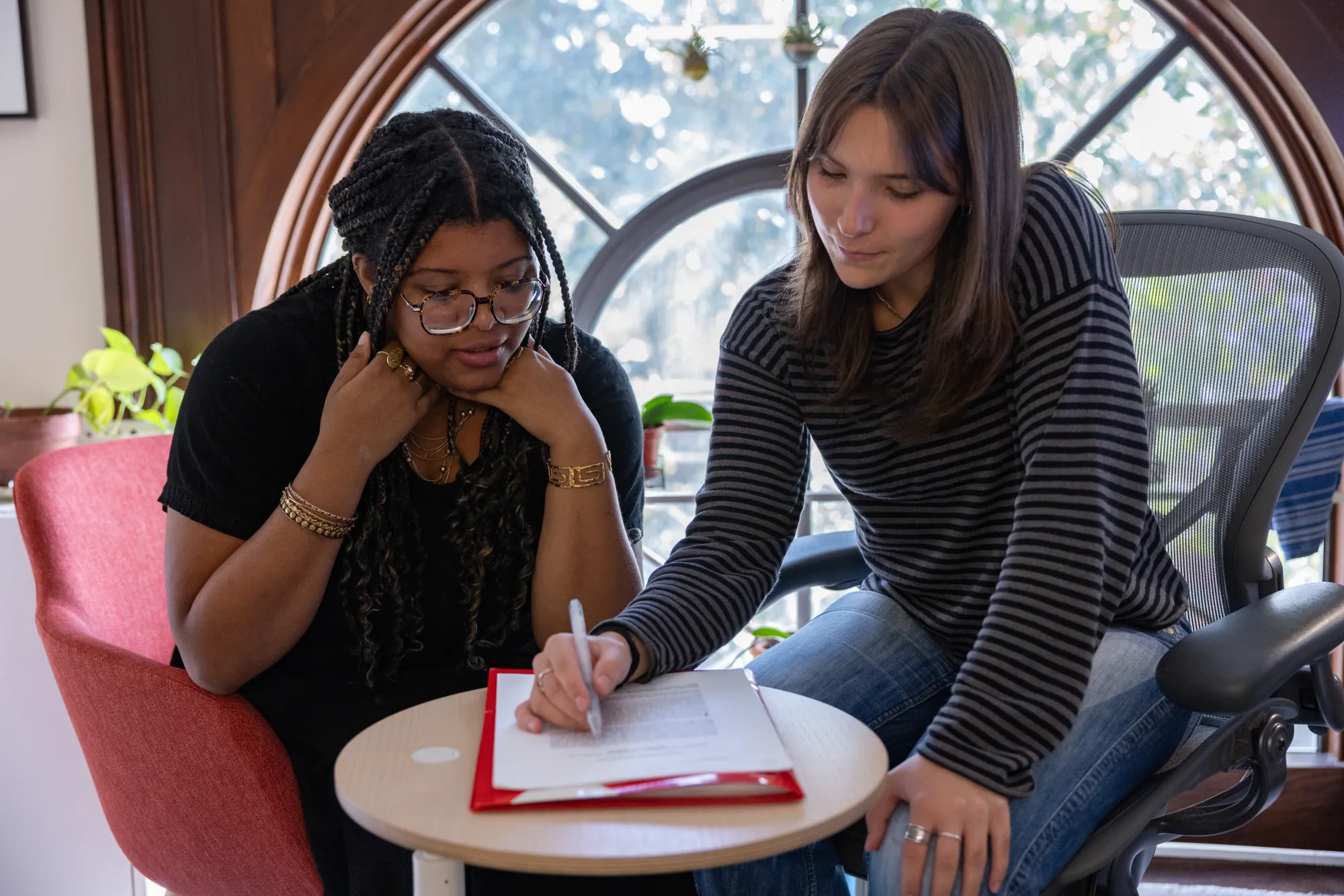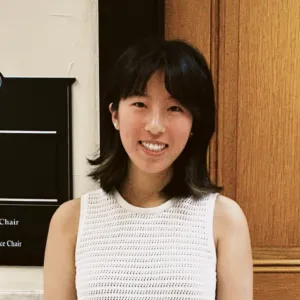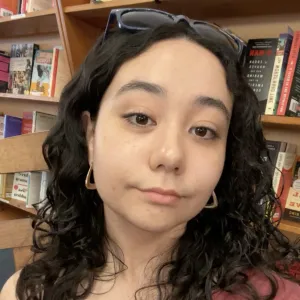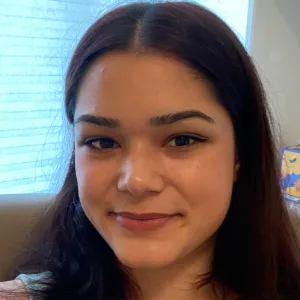Student Resources
The Jacobson Center offers individual writing conferences, the opportunity to use student tutors or serve as a student tutor, and workshops on time management, study skills, public speaking and other academic issues.
Meet with a Tutor
Peer Content Tutor Appointments
Peer Content Tutors are available to support language courses and a variety of other non-quantitative subjects.
Hours
Monday–Friday, 8:30 a.m.–4:30 p.m.
Sunday–Thursday, 7–10 p.m.
Scheduling Tutorial
Writing & Speaking
The Writing Process
This series doesn’t pretend to explain every stylistic nuance or arcane grammar point, nor do we explore every genre in which you may be asked to write at some point. This series is also not intended to replace an appointment with a writing counselor or student writing assistant, still the most effective way to improve your writing and yourself as a writer. This series aims to offer advice and strategies relevant to the main issues most writers confront, particularly if your assignment involves the most common of writing tasks at Smith—the classic 4–6 page academic essay.
Getting Started
Beginning a writing assignment causes many writers to feel anxious. But when you use a few simple techniques, the process can be smoother, more efficient, and ultimately effective.
Read Your Assignment Carefully
What is it asking you to do? Summarize? Analyze? Compare and contrast? Define? Explicate? Having a good grasp of your instructor’s expectations will allow you to decide on the approach you need to take with your paper. Suppose your instructor asks you to analyze the role of Christianity in the fall of the Roman Empire. Such an assignment does not require you to discuss the differences between the Christian faith and paganism. Rather, this assignment calls on you to build an argument explaining how and why Christianity affected—or did not affect—the decline of the Roman Empire.
When Your Assignment is Open-ended, Go Back to Your Notes
When your instructor tells you to write a paper “on any aspect of the novel Moby Dick that interests you,” you need to consider all that you’ve learned and thought about that novel so far. Review the lecture and discussion notes you’ve taken and identify aspects of the book that have raised questions, provided insights, or provoked your emotions. Then try writing on these ideas non-stop for a timed period (say, 10 minutes) and see where your words take you. (This is called free-writing.) Don’t hesitate to talk to your classmates or instructor about the ideas that interest you. Getting feedback on your ideas can help you clarify your topic. Always ask a question about the topic that your paper can answer: The answer to that question can serve as your thesis. For example, the question, “Why would Ahab be so obsessed with finding Moby Dick?” could become the thesis statement, “Ahab’s quest for Moby Dick reveals…”(you figure it out!).
Look at the Length Requirement for the Paper
A two-page paper requires you to make different writing choices than a ten-page paper would. The shorter the paper, the tighter the focus and the more narrow your argument must be. By contrast, a longer paper will allow you to explore an idea or issue in greater depth. If you have to write a short paper on ways to improve Social Security, it would be impossible for you to analyze and assess all the conflicting proposals for overhauling the system in two pages. However, you could look at one aspect of one proposal in a short paper:
Individuals should be able to invest their own Social Security dollars in the stock market.
Start this Process Early
As soon as you get your assignment, begin to work on it. When you allow yourself time for reflecting, free-writing, drafting, editing and revising, you can break the process into manageable stages, avoid last minute panics, and have more control over your work!
Copyright 2000, the Jacobson Center for Writing, Teaching and Learning at Smith College.
The First Draft
As you prepare to write the first draft of a paper, you should already know what your instructor is asking you to do and what topic you’re exploring. (See #1 Getting Started.) You also need to assess your audience for the paper. Once you know the purpose of your essay and the audience for whom you’re writing, you can create a workable thesis statement and begin building an argument that supports it.
Assessing Your Audience
In general, you can assume that your audience for any given paper is your instructor as well as your classmates. In other words, you’re writing for people who know the material that you’re discussing. Thus, you should avoid providing unnecessary or irrelevant information on your topic. If you’re writing a paper on Jane Austen’s Emma for a literature class, you don’t need to spend time providing a plot summary or a biographical sketch of Austen herself. Your instructor and your classmates have already read the novel and know something about Austen. Your paper should assert a conclusion or an insight about the novel that you prove through your analysis of the text.
There are times, however, when your instructor will ask you to write to a specific imagined audience. You may be required to write a grant proposal, a newspaper editorial, or a legal brief. You still need to assess the purpose of your writing and the audience to whom you’re directing it, because you need to make sure your writing doesn’t include information your audience already knows or exclude information they may need.
Creating a Thesis
In the simplest terms, a thesis statement is a conclusion that you’ve reached about your topic. You must prove your claim using sound arguments throughout your paper. When you create a thesis, you need to choose one that is appropriate for the length and scope of your paper. Your thesis should also be somewhat contentious; in other words, you need to avoid self-evident statements. The following thesis statement is undeniably true, but a poor thesis for a paper because it is self-evident:
Pol Pot was one of the most monstrous leaders of the twentieth century.
Such a statement gives you nothing to argue, no facts to analyze; no one would offer a counter-argument. The following statement would work more effectively:
American intervention in Cambodian politics during the Vietnam War played a significant role in bringing the Khmer Rouge to power.
You could analyze and discuss the existing facts to prove this claim. There are certainly counter-arguments to this position that you’d have to address and refute.
Developing Arguments
A logical argument depends on sound evidence. Depending on the subject matter, you’ll gather your evidence from appropriate outside sources (books, periodicals, the internet), or base it on your own research and analysis. (See #12—Using Sources.) Suppose you want to make the following argument:
The current emphasis on lowering cholesterol to prevent heart disease is misplaced. Recent research shows that specific vitamin deficiencies are far more accurate as predictors of heart disease than is high cholesterol.
An effective argument would involve your presentation of the case for lowering cholesterol and then your refutation of that case based on your presentation and analysis of the new research documenting the connection between vitamin deficiencies and heart attacks. The evidence for this paper could not be your own opinion: the evidence would have to be reputable, tested science.
When you argue for your point of view about literary or religious works, a piece of music, or other subjects in the humanities, you may at times gather scholarly evidence in support of your opinion. However, the majority of your paper should be based on your own analysis of textual evidence. Suppose you want to assert that the imagery in Toni Morrison's The Bluest Eye intensifies a reader's understanding of the insidious effects of racism. To prove this thesis, you'll need to examine a specific image or images and argue why and how Morrison's use of imagery helps readers understand the way racism affects a family member or members:
In analyzing several images of eyes and seeing in The Bluest Eye, the reader comes to understand how Pecola’s obsession with blue eyes reveals her own internalized racism.
In summary, the first draft of any paper should contain a thesis statement that you develop by means of a sound argument. Although arguments often appeal to a reader’s emotions or ethics, academic arguments must be logical and well-reasoned to be sound and, therefore, persuasive to a reader.
Copyright 2000, the Jacobson Center for Writing, Teaching and Learning at Smith College.
As a student, you’ll be asked to write many different types of essays. Comparison-and-contrast essays and book reviews are common assignments in humanities and social science classes, while lab reports are basic requirements for science classes such as biology, chemistry, and physics. Below are some suggestions to help you begin these different essays.
Types of Essays
Comparison and Contrast
The comparison-and-contrast essay is one of the most frequently assigned. In this type of essay, your goal is to construct an argument based on a discussion of the similarities and/or differences in two or more texts, theories, or objects. Simply pointing out the similarities and differences is not enough; you also need to state why these similarities/differences matter. For example, in a religion paper you might begin by comparing and contrasting how two religious texts approach the idea of the self, but then move on to formulating a thesis about what role the self plays in achieving enlightenment.
When writing a comparison-and-contrast essay, you should begin with an introductory paragraph that introduces the texts and includes a clear thesis statement about them. In some cases, depending on your audience, a brief summary of the texts would also be appropriate.
You can organize the body of the comparison-and-contrast essay either subject-by-subject or point-by-point. In the first pattern of organization, subject-by-subject, you would discuss all your assertions about one subject and then all your assertions about the second subject. Here’s an example:
Introduction (Thesis: In the past ten years, flexibility in several key areas has helped private colleges be more successful in achieving their diversity goals than public colleges.)
-
A. Private colleges
- 1. Funding
2. Curriculum
3. Admissions Policy
B. Public colleges
- 1. Funding
2. Curriculum
3. Admissions Policy
Conclusion
- 1. Funding
Sometimes organizing a comparison-and-contrast essay by subject tends to break up the analysis and make the essay seem choppy. If so, you can try organizing point-by-point. In this pattern of organization, you would discuss one assertion about both subjects, then another, and another, etc. Here’s an example:
Introduction
- A. Funding
- B. Curriculum
- C. Admissions policies
- 1. Private colleges
2. Public colleges - 1. Private colleges
2. Public colleges - 1. Private colleges
2. Public colleges
- 1. Private colleges
Conclusion
Book Reviews
Like other types of essays, a book review needs a well-articulated thesis as well as strong evidence supporting that thesis. It should not be just a summary of the book; rather, it should be a thoughtful, analytical evaluation. Listed below are some points often addressed in a book review:
- The book’s thesis and a brief summary.
- A discussion of the author’s background and professional credentials.
- An evaluation of the sources that the author uses to support the thesis. What are they? How has the author gathered them? Are they biased?
- An evaluation of the book’s central argument. Is it logical? Is it based on valid assumptions? Is it consistent with or different from other work on this subject?
- An evaluation of the book’s style. Is it lively and engaging or dull and unappealing? Is the style appropriate for general readers or scholarly readers?
- An evaluation of the book’s overall contributions. Does it provide interesting new insights? Does it contribute to the larger discussion of the subject?
Lab Reports
The purpose of a lab report is to provide an accurate record of your experiment and to communicate that you understand the science involved. Although the format of a chemistry lab report can vary somewhat from that of a biology or physics lab report, all generally include the following section, which should be introduced with separate subheadings:
- Introduction: a brief discussion that includes a statement of the purpose of the lab as well as some background information that provides a context for your work.
- Experimental: a concise description of what you did and what you observed. This section can also be referred to as Methods and Materials
- Results: a report of your findings. Sometimes results can be reported in the Discussion section.
- Discussion: a detailed discussion of your results and an interpretation of your data and observations. This section can also include your conclusions.
- References:a list of relevant sources.
Copyright 2000, the Jacobson Center for Writing, Teaching and Learning at Smith College.
Introductions and Conclusions
Introductions and conclusions are not just paragraphs that occur at the beginning and end of a paper. They form a dynamic partnership that encloses and enhances an argument. By moving between them, revising each in light of the other, you can clarify your point and clinch your argument. Let’s move between an introduction and conclusion of our own.
Rough Introduction
America is stronger today because of the contributions of other cultures, like Columbus, the Italian, who claimed the New World for Spain. So we should be thankful, not angry with immigrants who pursue the American dream. My Aunt Gina, poor and hungry, came from Sicily in 1945. Mussolini had been deposed. World War II was over. To New York she came and went to work for a small importer of Sicilian olive oil. The company is worth millions today, and her contributions can’t be discounted, nor can the contributions of all the others before her or after her. That’s why it’s wrong to put limits on immigration, though illegal immigration is another matter.
This introduction is rough because it raises too many questions. Is this a paper about Aunt Gina or immigration? How relevant is Columbus? Do we need to hear so much about World War II? Generalizations such as "the American dream" only add to the fuzzy effect. Illegal immigration may be pertinent, but is it central?
You may wish to stop everything and revise such an introduction, and you’re not wrong to feel that way—but don’t do it yet. Go back later when the meaning of the paper has emerged, when it’s easier to know how to revise. In other words, write all the way through to the conclusion just to see how your thinking comes out.
Strange as it may sound, a conclusion is the best friend an introduction has. In writing a conclusion, the writer often draws together ideas and draws out the most significant implications. Let’s see what an early conclusion to the paper about Aunt Gina (or is it about immigration?) looks like:
Like many immigrants, both legal and illegal, Aunt Gina worked for years at rock bottom wages. Without low wage workers the U.S. economy would undergo a wrenching transformation; many Americans, not just immigrants, would suffer the consequences. In spite of her value to the economy, Gina and others like her have been the targets of campaigns of hate. Anti-immigration hysteria that scapegoats newcomers doesn’t make America stronger. It makes America weaker.
Here the writer identifies her subject, the bashing of immigrants and punitive anti-immigration legislation. She’s also made clear what’s at stake, the health of the American economy, no less. Now it’s time to revise the introduction so that it works more closely with the conclusion, so that they fit.
If, in an early draft, you address your main idea for the first time in the conclusion, or address it with greater effectiveness, why fight it? Such a conclusion might make a fine introduction, so move it to the beginning and revise it, and no one will know the difference! But that requires writing a new conclusion, of course, preferably one that really concludes. Too often, even in revised papers, the last paragraph is a restatement of the first. This creates the impression that in spite of all the ground a paper has covered the argument has arrived nowhere.
Why not tailor the introduction to fit the conclusion? If the conclusion delivers an answer, ask an appropriate question (for example, “Does immigration harm the U.S. economy or help it?”), and place the question in the introduction. You can also restate the question as an issue the paper will resolve. Even if a conclusion raises new, but related issues, or examines the significance of what has been learned, these elements can help a writer craft an opening that anticipates the main point without giving the game away.
Revised Introduction
When I think of the immigrant experience, I think of Aunt Gina. After World War II, she left Sicily for New York and went to work for a small importer of olive oil. The company is worth millions today, and her contributions to its success, while modest, can’t be discounted. The truth is that Aunt Gina worked all her life for low pay. Now, in the wake of political campaigns against “illegal immigrants,” and the enactment of laws that punish legal and illegal immigrants alike, the real contributions of low wage workers to American prosperity are being cynically overlooked.
Happily, Columbus is gone. So is the extraneous stuff about World War II. Illegal and legal immigrants fall under one category now—low wage workers whose contributions to American prosperity (not the “American dream”) are too often overlooked.
Once you’re happy with the introduction, it’s time to polish the conclusion, starting with the first line. Avoid the formulaic: “In conclusion,” “To sum up,” “In summary,” or “Thus we see that…” The alert reader will know that the conclusion has arrived by the fact that there are no more pages left. Concentrate instead on a transition that engages the main idea, improves the fit.
Sometimes writers like to close with a quotation, and it’s fine if you do that, but be sure it amplifies the main point or puts things in perspective. Too often, a closing quotation has a “So what?” effect, especially if it restates points already established.
Indeed, “So what?” is a useful question to ask when ending a paper. Where has the argument of the paper taken us? Redefining the key terms of an argument can accomplish the same effect, especially when the redefinition answers the question, "So what?" and reveals the significance of your thesis.
Remember: The introduction and conclusion of a paper are your first and last chance to persuade the reader. Be sure to make the most of the opportunities they present.
Copyright 2000, the Jacobson Center for Writing, Teaching and Learning at Smith College.
Paragraphs and Transitions
A paragraph is a unit of thought. Unit by unit, your paragraphs together develop your paper’s thesis. In other words, the central ideas of each of your paragraphs, in sequence, represent an outline of your argument.
Good paragraphs are unified and coherent. You’ll find that unified paragraphs often develop a topic sentence that announces the paragraph’s theme or controlling idea. Here’s an example:
Freudians are self-contradictory and dogmatic. They contradict themselves whenever they speak of analysis as “The Cure” and at the same time encourage patients to think of analysis as an open-ended process, often lasting for decades. They’re maddeningly dogmatic when they meet every criticism with a reference to one of their sacred texts, as if the great Sigmund had an answer for every problem in the modern world.
In this example the topic sentence is the first sentence in the paragraph. Most of the time it’s reassuring to your reader to find it there. (It’s also helpful to you as a writer; a strong topic sentence means you know from the beginning what you want your paragraph to be about.) Occasionally you may want to locate your topic sentence in the middle of the paragraph, or perhaps to build up to it at the end. Sometimes a paragraph doesn’t have an explicit topic sentence, but if not, the paragraph should be so unified that a reader would have no difficulty summarizing its central point.
Irrelevant details or a shift in focus can disrupt paragraph unity. Let’s look at our example again, after a less disciplined writer has had a crack at it:
Freudians are self-contradictory and dogmatic. They contradict themselves whenever they speak of analysis as "The Cure" and at the same time encourage patients to think of analysis as an open-ended process, often lasting for decades. Analysis can be expensive, too; many Freudian practitioners charge as much as $250 for 50 minutes, and since this can go on for years, a patient may be left with staggering debt. They’re maddeningly dogmatic when they meet every criticism with a reference to their sacred texts, as if the great Sigmund had an answer for every problem in the modern world.
The sentence this writer has added is distracting; how much analysis costs isn’t really the point. And the sentence not only disrupts the paragraph’s unity, it shifts its focus from Freudians and their theory to the perspective of the suffering, impoverished patient.
Paragraphs should be coherently organized as well as unified. In our first example the writer’s organizational plan is clear: she takes the first term in her topic sentence, self-contradictory, and explains it; then she does the same for the second term, dogmatic. Many other kinds of organization are possible: for example, you can describe something from the outside to the inside; you can go from the general to the specific or vice versa; you can proceed chronologically. Just be sure that the reader can tell what your plan is. Be sure you have a plan.
If each of your paragraphs is unified and organized, you next need to look at them together to be sure they’re in the right order. If they aren’t, rearrange them so the sequence makes logical sense. When it does, you usually don’t have to worry much about transitions, because the logic of each paragraph will carry you naturally into the next. Writers who have big trouble with transitions are often making a cosmetic attempt to conceal an underlying organizational problem: not all the so-called "transitional expressions" in the world (similarly, furthermore, indeed, and the like) will help if your basic problem is the order of the paragraphs.
But if the logic is there, transitions are easy. Suppose the next paragraph in our essay on Freudian theory goes like this:
Analysis was suited to a more leisurely past, a more verbal culture, an age when the elite felt entitled to every self-indulgent therapy that presented itself. Modern Freudians need to remind themselves that every great religion has adapted itself and its sacred texts to the demands of new times, new scientific discoveries, new modes of thought.
Let’s put it together with the first paragraph, and see how the transition practically writes itself:
Freudian theory is often both self-contradictory and dogmatic. Freudians contradict themselves whenever they speak of analysis as "The Cure" and at the same time encourage patients to think of analysis as an open-ended process, often lasting for decades. They’re maddeningly dogmatic when they meet every criticism with a reference to one of their sacred texts, as if the great Sigmund had an answer for every problem in the modern world.
But Sigmund didn’t, and neither do modern Freudians. Analysis was suited to a more leisurely past, a more verbal culture, an age when the elite felt entitled to every self-indulgent therapy that presented itself. Modern Freudians need to remind themselves that every great religion has adapted itself and its sacred texts to the demands of new times, new scientific discoveries, new modes of thought.
Transitional expressions such as likewise, similarly, in addition, consequently, accordingly, admittedly, although, indeed, chiefly (and many others) can be very useful, especially if the relation between sentences or paragraphs may not be immediately clear to the reader, or if you want to emphasize certain aspects of these relationships. But there’s no substitute for a coherent organization of your paragraphs themselves and of the sequence in which you place them.
Copyright 2000, the Jacobson Center for Writing, Teaching and Learning at Smith College.
Higher and Lower Order Concerns
You should divide revision and editing concerns into two kinds: higher order and lower order. Tackle higher order first. Once satisfied with those, move on to the lower order.
What are Higher and Lower Order Concerns?
- Higher order concerns are thesis and focus, audience and purpose, development and organization. These come first.
- Lower order concerns are editing and proofreading. Deal with these later.
- In practical terms, it’s true, you might find yourself contending with more than one concern at a time. For example, following a logical order of ideas can help refine a thesis; the right word can unlock the right order of words. But if you’re stuck, take a step back, and work on one concern at a time, and separate your higher order concerns from your lower order concerns.
Higher Order Concerns
Try to work on higher order concerns in stages: focus on the main idea first; identify your audience; check your argument.
Thesis: Be sure that your paper contains a sentence stating its main point. Try looking for the sentence in your introduction and conclusion. There should be a main idea in there somewhere, preferably one that answers the question “How?” or “Why?” (For more tips on shaping a thesis, see handout #2—The First Draft, and #4—Introductions and Conclusions above.)
Audience: Is your paper appropriate for your audience? Knowing your audience helps determine whether you need to define terms or provide background, or how much analysis is required to explain your thinking. Unless the assignment identifies a specific reader, think of your professor and classmates as your ideal audience; they’ve read the texts, but do they see what you see? Explain yourself to them.
Development and organization: Does your argument need work? If paragraphs are undeveloped, you may need more evidence or analysis or both. Does your paper progress in a logical way? Don’t hesitate to move paragraphs; you can always move them back. Try to strengthen the connections between points, which means improving your transitions. (For more tips on developing an argument, see #4—Introductions and Conclusions, and #5—Paragraphs and Transitions.)
Lower Order Concerns
Now’s the time to move on to lower order concerns. These, too, can be divided into stages: edit your prose first; then proofread.
Sentences: Take a close look at the shape and length of your sentences. A sentence that takes too long, or two sentences that say the same thing can create blocks of verbal concrete. Keep chipping away at that concrete, cutting away everything you don’t need.
Read your paper aloud. If you run out of breath while reading, you might want to consider breaking up the sentence. Or you may hear too many sentences that are all the same length or constructed the same way. Edit for variety.
Reading aloud can help you catch run-ons and sentence fragments, too. It’s important to repair these. They’re more than cosmetic errors; they impede understanding. (For more tips on editing sentences, see handout #7—Style and #8—Fragments and Run-on Sentences below.)
Word Choice: Do your word choices suit the purpose of your paper and your audience?
Beware of fancy, pompous words. Do you really want to use “plethora” when “too many” will do? Simple, concrete words can achieve great power when placed in a strong, lean sentence.
Avoid vague words. A word such as “thing” isn’t helpful, especially when you mean something more specific, a situation, an event, or a statement. Use words that tell us what you really mean, not words that obscure your meaning.
If you hear a phrase all the time (“the bottom line”), or see it again and again in newspapers and magazines or on the Web, it’s probably a cliche. Come up with something more original. Consider it a challenge! (For more tips on choosing the right words, see handout #7—Style below.)
Punctuation: Once you’re satisfied that the right words are in the right place, work on punctuation. (See handout #11—Punctuation below.) Why agonize over a comma if you’re not satisfied with the sentence in the first place? Every revision requires re-punctuation, so don’t start re-punctuating until you’ve finished revising.
Spelling, Typos, etc.: Now that you’ve worked down the list of concerns from the highest to the lowest order, you’re ready to proofread. Spell Check is useful, but it’s a good idea to consult that old standby, the dictionary, too. (For more tips on catching and correcting mistakes, see handout #13—Polishing and Proofing below.)
Copyright 2000, the Jacobson Center for Writing, Teaching and Learning at Smith College.
Style
As you work toward a final version of your draft, your attention should turn to stylistic issues. Your goal as a stylist is precise, clear prose.
Wordiness
- Don’t waste space on windy repetition of the terms of the assignment.
- There are many similarities and differences between Samuel Coleridge’s “Rime of the Ancient Mariner” and John Keats’ “Ode on a Grecian Urn.”
- Don’t clutter up your sentences with filler. Empty phrases like there is and there areengender other clutter (many which’s and that’s, for example). In the following sentence, by getting rid of “There is,” you shorten and strengthen the sentence:
- There is one tree central to the composition which is large and fills the picture space. (original, 16 words)
- One large tree, central to the composition, fills the picture space. (revision, 11 words)
- Similarly, avoid useless repetition of words or phrases.
- In the border closer to the image, there is a crease which runs through the border about one inch. (original, 19 words)
- Closer to the image, a one-inch crease runs through the border. (revision, 11 words)
- Avoid needlessly stringing together prepositional phrases (phrases headed by of, about, in, or, etc.). In the following example, you could use a combination of strategies to create a much leaner, more direct revision:
- One of the important chapters of the book that I find interesting is the one about the language of chimpanzees. (20 words, 4 prepositional phrases)
- The important chapter on chimpanzee language interests me. (8 words, 1 prepositional phrase)
Active and Passive Voice
You’ve probably noticed in the above examples that weak verbs like is and was contribute to wordiness, especially if they are part of what we call passive constructions.
The English language includes two “verbal voices”: passive and active. The active voice is usually more direct, concise, and vivid than the passive voice. In the passive voice, the subject of the sentence doesn’t perform the action, but is acted upon by someone or something. The verb is always some form of the “to be” verb, such as is, are, were, and was. Here’s a sentence in the passive voice:
Most academic prose is marred by jargon.
To change this sentence to active voice, eliminate the “to be” verb, is, and turn the word that follows it into a “real” verb:
Jargon mars most academic prose.
The real source of the action in the sentence often becomes clearer after revision from passive to active voice:
Lolita was called a brilliant but obscene book.
Get rid of the “to be” verb, ask yourself who called Lolita brilliant but obscene, and you come up with:
Critics called Lolita brilliant but obscene.
Alert: Don’t use the passive voice to give your own opinion spurious weight, as in:
Lolita was called a brilliant but obscene book.
The passive voice may be appropriate if the agent or the actor is unknown or unimportant:
The reagent was added to the solution in the beaker.
Louis Philippe was known as the Citizen King.
Parallel Structure
Parallel constructions—phrases or clauses within the same sentence that repeat the same grammatical structure—also help keep your prose tight. Using parallel structure almost always makes your sentences shorter, and at the same time it provides emphasis, reinforces meaning, and clarifies relationships. The last half of the sentence you just read embodied parallel structure nicely. Compare it to the following:
Parallel structure is usually economical, and it is emphatic, seems to reinforce meaning, and generally clarifies relationships.
Alert: When you make a comparison, be sure that the elements you’re trying to compare are parallel. In the following example the writer intends to compare two novels:
Like Bleak House, Joseph Conrad uses Lord Jim as an exercise in multiple narrators.
But because of the way she’s structured the sentence, she’s actually comparing a novel with a novelist (apples and oranges, some would say). A better way is to make the elements of the comparison parallel:
Like Dickens’ Bleak House, Conrad’s Lord Jim is an exercise in multiple narrators.
Copyright 2000, the Jacobson Center for Writing, Teaching and Learning at Smith College.
Fragments and Run-On Sentences
Correct grammar and usage will not by themselves make you a better writer; however, errors in grammar and usage may stigmatize you as a writer. Errors in sentence boundaries-fragments, run-on sentences-are among the most stigmatizing and may suggest incompetence or carelessness.
Fragments
A fragment is a grammatically incomplete sentence. Sometimes an expression is a fragment because it lacks a subject and/or a tensed verb that agrees with the subject (e.g. a verb form like run, runs, ran, have run, etc., as opposed to a verb form like to run or running, which does not carry tense or agreement with a subject). At a minimum, a grammatical sentence must have a subject and a tensed verb that agrees with it. Other times an expression is a fragment because it starts with a subordinating word that makes it dependent on a main sentence (e.g. after, although, because, since, when); these expressions cannot stand by themselves, without a main sentence.
Chomsky gave an inspiring lecture. His best lecture ever on universal grammar. (the fragment lacks a tensed verb agreeing with a subject)
Jane is very unhappy at MIT. Because she has become interested in sociolinguistics. (the fragment starts with a subordinating word that makes it dependent on a main sentence)
The best place to study linguistics. In my opinion it is not MIT but Stanford.
(the fragment lacks a tensed verb agreeing with a subject--the infinitive verb to study carries no tense or agreement)
Ways to Correct a Fragment
- Use a comma instead of a period to connect the fragment to the main sentence.
- Chomsky gave an inspiring lecture, his best lecture ever on universal grammar.
- Jane is very unhappy at MIT, because she has become interested in sociolinguistics.
- Add a subject and/or a tensed verb agreeing with it, making the fragment a complete sentence.
- Chomsky gave an inspiring lecture. It was his best lecture ever on universal grammar.
- Integrate the two sentences in an alternative, sensible way, tightening up the wordiness.
- In my opinion, the best place to study linguistics is not MIT but Stanford.
Run-On Sentences
A run-on sentence is a sentence comprised of two sentences connected with no punctuation at all or with only a comma (the proverbial comma splice).
Jane used to study linguistics at MIT she attends Stanford now.
Jane used to study linguistics at MIT, she attends Stanford now.
Ways to Correct a Run-On Sentence
- Place a period or a semicolon between the sentences. If the relationship between the two sentences is weak, you might also want to add a transitional word or expression (e.g. consequently, however, thus, as a result).
- Jane used to study linguistics at MIT. However, she attends Stanford now.
- Place a comma and a coordinating word (and, but, for, nor, or, so, yet) between the sentences.
- Jane used to study linguistics at MIT, but she attends Stanford now.
- Subordinate the first sentence with a subordinating word (e.g. after, although, because, since, when) and place a comma between the two elements.
- Although Jane used to study linguistics at MIT, she attends Stanford now.
Copyright 2000, the Jacobson Center for Writing, Teaching and Learning at Smith College.
Eleven Trouble Spots in Subject-Verb Agreement
Many people are uncomfortable with grammar because they’ve been frustrated by it in the past, and not without good reason, too, given the number of rules, their complexity, and all the terminology necessary even to understand them. To complicate, there are probably more exceptions to rules than there are rules. Comfort with the rules of grammar will make you a more fluent, confident writer, however. If reading a rule doesn’t help you understand it, remember it, or figure out when it applies, you may find it more useful to study the example and come up with your own guidelines. Try it!
- Verbs always agree with their subjects, even when the subjects are far away.
- The second entry in this long list of books and articles interestsme most.
Alert: Expressions like as well as, in addition to, accompanied by, together with, and along with do not affect subject-verb agreement.
- This book, together with the related articles, clarifies the situation for me.
- Compound subjects (two subjects connected with and) take plural agreement.
- Professor Meyers and her assistant have completed their groundbreaking work.
- Lists preceded by each and ever take singular verbs.
- Every novel, play, and poem I read motivates me to become an English major.
- However, lists followed by each take plural verbs.
- A novel, a play, and a poem each manifest a different use of language.
-
Verbs agreeing with compound either...or/neither...nor expressions agree with the element closest to them.
- Neither the book nor the journal articles help in understanding the Asian monetary crisis. (help agrees with articles, the closest element)
Tip: If one element is singular and one is plural, placing the plural second (closer to the verb) makes the sentence more idiomatic.
- Indefinite pronouns almost always take a singular verb.
Examples of indefinite pronouns:
anybody either neither somebody anyone everybody nobody someone anything everyone none something each everything no one Everybody agrees that Tibet has undergone profound changes in recent history.
- Collective nouns (nouns with a singular form referring to a group) take a singular verb.
- The audience applauds on cue.
- To emphasize each individual in the collective, the collective nouns can take a plural verb.
- The audience were already pushing and shoving past each other when the curtain dropped.
Alert: The expression the number takes a singular verb, while a number takes a plural one.
The number of women with PhDs in computer science is small.
Consequently, a number of scholars are advocating for educational reform.
- Units of measurement take a singular verb when they refer to a collective entity and a plural one when they refer to individuals.
A quarter of the gas condenses within 15 seconds.
A quarter of the tests reveal nothing that we don’t already know.- Verbs agree with their subjects even when the subjects are placed out of order for stylistic effects.
There are seven tests in the procedure.
(seven tests is the real subject)- Verbs never agree with their subject complements (the object-like expressions following the verb to be), even though you may feel a tendency to make them do so.
Drafting and revising arethe best way to improve one’s writing.
- Who, which, and that agree with the nouns to which they refer.
Support your local food co-op, which is worker-owned.
(which refers to co-op, which is singular, so the verb is singular)- Some words have plural forms (e.g. the disciplines as bodies of knowledge: economics, physics; or diseases: mumps, measles), but take singular agreement.
Statistics belongs in a college’s basic curriculum.
- However, when these words refer to single items, they take plural agreement.
Regarding teenage pregnancy,the statistics astound me.
- The titles of works and words written as words take a singular verb.
In conclusion, Sons and Lovers deserves a very high place in the literary canon.
Bats is the plural of bat.
-
Copyright 2000, the Jacobson Center for Writing, Teaching and Learning at Smith College.
Five Trouble Spots in Pronoun Agreement
Just about all native speakers (and most fluent non-native speakers) have good intuitions about correct grammar regarding simple pronoun-antecedent and subject-verb agreement rules; in other words, they know and observe the rules without knowing that they're doing it. However, some expressions present difficulties for all speakers, often because they're arbitrary but have nonetheless become enshrined in the standard language over the years. For these expressions, appealing to intuition doesn't always work, and often neither does appealing to form or meaning because these expressions are in fact so arbitrary. The expressions below usually present the greatest confusion in pronoun-antecedent agreement.
-
Indefinite pronouns take a single pronoun, even though they may sometimes seem plural in meaning.
Examples of indefinite pronouns:
| anybody | either | neither |
| somebody | anyone | everybody |
| nobody | someone | anything |
| everyone | none | something |
| each | everything | no one |
Everybody who thinks that he or she is depressed should consult a professional.
- Generic nouns take singular pronouns.
Every novelist has his or her favorite characters.
A smart novelist nowadays should write his or her books for a multicultural market.
General note: To avoid the wordiness of he or she without affecting the meaning of a sentence, pluralizing antecedents and subsequent pronouns usually works, in this case:
Novelists have their favorite characters.
Smart novelists nowadays should write their books for a multicultural market.
Collective nouns (nouns with a singular form referring to a group) take singular pronouns.
Examples of collective nouns:
| jury | committee | audience |
| crowd | class | troupe |
| family | team |
The family moved back to its hometown.
To stress individual members of the group, use a plural pronoun.
After Jesse revealed her so-called news, the family scattered to their respective rooms.
- Compound expressions connected by and take a plural pronoun.
Freud and Jung quarreled and went their separate ways.
- Pronouns referring to compound expressions connected by or, nor, either...or, and neither...nor agree with the closest element.
Neither Chomsky nor his followers integrate sociolinguistics into their theories.
(followers is closer to the pronoun than Chomsky)
Tips: When one element is singular and the other plural, placing the plural element second makes a more idiomatic sentence.
When one element is male and the other is female, the sentence is almost always awkward. In these cases, revise the sentence using a different sentence structure.
Copyright 2000, the Jacobson Center for Writing, Teaching and Learning at Smith College.
Effective Use of Punctuation
Punctuation helps you clarify how a sentence should be read. It is useful to think of the comma, the semi-colon, the colon, and the dash as signs which assist a reader in grasping where a sentence is going.
The Comma
The comma is primarily a separating device. Think of it as road sign that signals to the reader the need to pause.
- Use a comma to separate an introductory element from the main clause.
- If you don’t like Kant, you certainly won’t like Hegel.
- Use a comma before a coordinating conjunction (for, and, nor, but, or, yet, so) that joins two complete sentences. (Some people use the acronym FANBOYS to remember these words.)
- I can read Kant, but I can appreciate Hegel.
Alert: Pairs of words, phrases, or dependent clauses joined by a coordinating conjunction should not be separated with a comma.
I like Kant and Hegel.
The Semi-Colon
The semi-colon is primarily a linking device used to join two complete sentences closely related in meaning. The two sentences are usually about the same length, too.
- Use a semi-colon to join two complete sentences.
- I understand Hegel; I admire Kant.
- You can also use the semi-colon as a less confusing additional barrier between items that are already separated by commas.
- We study the Cavalier poets Lovelace, Carew, and Suckling; the metaphysical poets Donne, Cowley, and Crashaw; and the religious mystics Herbert, Vaughan, and Traherne.
The Dash
Like the colon, the dash is a linking device, but it is not necessary that what precedes it be a complete sentence. Use it when the word or word group that follows it constitutes a summation, an amplification, a commentary, an explanation, or a reversal of what went before. You can use the dash very effectively to create special, dramatic emphasis, but use it only very occasionally. Overuse of the dash can make your prose appear fragmented and incoherent.
Over 104 pounds a year—this is how much sugar is in the average person’s diet.
Use dashes in pairs to enclose abrupt parenthetical elements that occur within a sentence.
Southern novelists—and Hemingway at his best—are the most important American writers of the post-war years.
Copyright 2000, the Jacobson Center for Writing, Teaching and Learning at Smith College.
Effective Use of Sources
When you write a paper you generally draw on at least three types of materials: your own thoughts and insights; standard, commonplace knowledge (such as proverbs, fairy tales, or well-known historical facts); and the particular thoughts, insights, or words of someone else. This last category raises some special concerns. As you revise, spend some time looking at the way you’ve used your sources.
When to Quote
Don’t pack your paper with huge blocks of quotations or intersperse every sentence with quoted words and phrases. You’ll drown out your own voice. Quote only when you can answer the following questions with a yes:
- Are the words themselves at issue in your paper?
- Is the language of the source especially vivid or colorful or precise?
- Will paraphrase or summary lose or distort meaning?
- Will a direct quotation harness the authority of the source more effectively?
- Will the exact words reinforce emphatically what you’ve already said?
Integrating Your Sources
Be sure that your reader always knows the relationship between your sources and your own argument. If you agree with the quoted author, make that clear (for example, you could introduce the quotation by saying “As Johnson perceptively notes. . . .“ If you’re skeptical, try “Johnson admits, somewhat defensively. . . .”). Don’t expect your reader to see the quoted material in the same light that you do; your responsibility is to guide the reader by telling her what you make of it for purposes of your argument.
On the stylistic level, integrate your sources smoothly with your own sentences. Take a look at the following sentence:
The review concluded with “Given Dickinson’s popularity, a new edition of her work is likely.”
The unfortunate conjunction of “with” and “Given” is probably something you wouldn’t put up with in your own prose; don’t let it get by just because you’re working with a quotation.
Alert: Avoid using too much punctuation just because you’re quoting. In the following example, the comma after “that” is superfluous:
Johnson claims that, “Jones is a true protectionist.”
You’ll probably introduce most of your quotations with verbs like claims, states, asserts, writes. As a rule of thumb, if you use a that after these verbs, do not use a comma (as in the above example). If you omit the that, use a comma after the verb for clarity. (See the write-up on the colon in handout # 11 above for more discussion of quotations and punctuation.)
Acknowledging and Documenting Your Sources
You have no obligation to acknowledge your own ideas and insights, of course, nor is it necessary to acknowledge commonplace information readily available to anyone. You may not know, however, what counts as commonplace information in a particular field of study until you do some reading in it. As you read, notice what the experts do and follow their lead. If they cite the information, that means that they don’t consider it commonplace, and so neither should you. Likewise, if they treat it as commonplace, so can you.
If such information is at all controversial or its origins problematic, however, you must acknowledge. For example, in most contexts the population of Iowa would be common information, but if your paper’s context suggests census tampering and political scandal, your reader needs to know the source of the population figures you use.
You must always cite your source when you quote even a few words (and, of course, those words must be in quotation marks).
You must always cite your source when you paraphrase or summarize someone else’s ideas or observations.
How to Acknowledge
Different disciplines use different formats or styles for citing sources. English, for example, uses the style of the Modern Language Association (MLA), while psychology and most other social sciences use the style of the American Psychological Association (APA) and so on. While all styles of citation share the common purpose of acknowledging the debt and enabling the reader to locate the exact source of the information, styles differ markedly in form and arrangement. When in doubt, ask your instructor what style you should use. Many handbooks and style sheets outlining the conventions of these various styles are available at the Jacobson Center.
Copyright 2000, the Jacobson Center for Writing, Teaching and Learning at Smith College.
Polishing and Proofing
If you’ve gotten this far, you’re probably happy with your thesis and unlikely to change your paper in fundamental ways. But the final touches can seriously affect the impression your paper makes on a reader. Here’s a checklist:
- Make sure your organization works well: The best way to do this is to make a “post-writing outline.” That is, write down, in sequence, the main idea of each paragraph. These main ideas are the skeleton of your argument: are all the bones in the right places? Would a late paragraph be more helpful if you moved it up to p.1?
- Presumably you’ve already carefully edited your paper (see sections 6-11 on Revising). If you haven’t, do it now.
- Don’t make the mistake of allotting only a few minutes for proofreading. When you’ve spent a lot of time and thought on a paper, you don’t want your reader’s impression of it to be spoiled by many annoying (even if trivial) errors. That kind of carelessness subtly undermines your reader’s confidence in you as a writer, so that even your best ideas won’t be as convincing as you thought they’d be.
Three Suggestions For Effective Proofreading
- Put some distance between yourself and the paper—time if you have it, space (physical or psychological) if you don’t. Don’t try to proofread just after you finish writing; at that point you’re still too close to what you’ve written. You need to find a way to come back to it with fresh eyes.
- Read slowly and read every word. Some people actually proofread backwards, or right to left, so they see each word not as a part of a unit of meaning, but as a word. Others, who don’t quite have the patience for this technique, separate the text into individual sentences by pressing the spacebar after each sentence.
- Don’t try to proofread for everything at once. Read through the paper for grammatical problems, then for punctuation, then for spelling.
On the subject of spelling--don’t rely on the spell check. If you mean “their” and write “there,” the computer won’t tell you. Pay special attention to the spelling of proper names: if you consistently spell Jane Austen’s last name as “Austin,” your English teacher may be too irritated to give your brilliant thesis about Emma the acclaim it deserves. Be sure you’re spelling key terms correctly: your art history instructor may not applaud your point about angels and putti if you’ve called them “angles” and “putty.”
Have you numbered your pages?
Copyright 2000, the Jacobson Center for Writing, Teaching and Learning at Smith College.
Most lab reports follow similar rules in their written structure. Different science departments vary in terms of what sections to include and the details needed in each section, and each department has specific rules about how to format your data, tables and figures. This handout discusses only writing, not data. However, most lab reports—and formal scientific papers—contain these basic sections.
Abstracts
The Abstract briefly summarizes the whole lab report. One good way to write a draft abstract is to write one sentence for each section of the report: one sentence of Introduction (or importance/purpose), one of Methods, one of Results, one of Discussion, and one of Conclusion (or ramifications/importance). Then revise for clarity. You may need a sentence more or less for any section depending on the needs of your particular lab. Not all lab reports require an abstract.
Introduction
The Introduction presents to the reader the purpose of the lab and contextualizes it by describing: 1) the state of knowledge in the area of inquiry, 2) the unanswered question to be investigated, and 3) the importance of answering the question. Introductions may be “right side up” or “upside down.” They may first describe the lab’s exact purpose or aims, and then put those aims in context. Or, the lab may first present the importance of the question within the field of interest, then the exact aims/purpose of the lab.
Methods
Methods are a narrative description of how the lab was conducted. They provide all the information — and only the information — necessary for the reader to repeat the lab and obtain the same results. Methods should not be written like instructions: “First, add 3 grams of solute to 50 milliliters of solution.” Rather, they should be narrative: “Solute (3 grams) was added to the solution (50 milliliters).” Also, avoid unnecessary information: “We walked across the room to use the sink.” Methods should be packed with numbers, like quantities or durations, as well as names/makes of equipment used. Some departments and scientific disciplines, such as Chemistry, require Methods to be written in passive voice.
Results
The Results section should present (surprise!) the results. However, many students find this section challenging. Your tables and figures go here, or are referenced here if attached to the end of the report. However, you must describe each table/figure’s main points IN WORDS, even if the table/fig is right there! For instance, “Figure 1 shows a positive linear relationship between incubation time and total microbial count until hour 10.” Important numbers, correlations and findings, with units, must be described. Unless you are doing a combined Results and Discussion section, avoid the temptation to explain what the results mean — just state the key data and relationships. Captions for tables/figures should be short: put details in the text.
Discussion
The Discussion may be rolled in as “Results and Discussion” or “Discussion and Conclusions.” The Discussion explains what your results mean, or interprets the results. Discussion frequently occurs AFTER results are presented. However, even in lab reports where Results and Discussion are presented together, it is good practice to separate each sentence presenting a result (piece of data) from a subsequent sentence that interprets that result. This order allows readers to draw their own conclusions from the data without the influence of the writer’s biases. Although no science can be completely unbiased, this format helps retain the distinction between What Actually Happened and What You Think Happened.
Conclusion
The conclusion is your chance to sum up the whole lab report. Your major findings/results, and their meaning, should be summarized for the reader here. Then, contextualize those findings for the reader by describing, in broad terms, 1) their implications, 2) how they influence/will influence the field in question, and 3) whether there remain any unanswered questions or further research to be conducted. Try not to repeat your introduction, but take a broader view toward the future.
Works Cited
Be sure to cite all information you obtained from other sources, including your review of any other literature. Use correct style: American Chemical Society (ACS) or American Psychological Association (APA) citation styles are common formats for the sciences. Introductions and Conclusions in particular should contain many in-text citations to prior work, with the extended reference information listed in the Works Cited.
Passive Voice in Scientific Writing
When should passive voice be used in lab reports and scientific writing? Passive voice is often used in Methods to emphasize the science performed. For instance: “Three grams of solute were added” emphasizes the solute, whereas “I added three grams of solute” emphasizes the scientist. Scientists have also traditionally used passive voice rather than “I” or “we” throughout their papers to downplay the individual scientist in favor of the science itself. However, this tradition is changing. Some scientists now believe active voice improves clarity and acknowledges the inevitable role of the scientist herself as well as any biases she may bring to the work. Ask your professors for their preference on passive voice.
Copyright 2013, the Jacobson Center for Writing, Teaching and Learning at Smith College.
Public Speaking
The Jacobson Center teaches a course WRT132: Public Speaking: Presentation of Self, Rhetorical Choices, and Agency. This 4-credit course covers the process of oral argumentation: picking and researching a topic, staking a position, writing scripts, and delivering speeches. Students will develop their writing, verbal and nonverbal communications skills, ability to present to an audience, and ability to adapt to different speaking contexts. We will aim to help students cultivate their unique voices in the public speaking challenges they face in their academic and professional careers.
Meet the Peer Writing Tutors
The Jacobson Center Peer Writing Tutors are available for appointments in Seelye 307 and drop-in services in the Neilson Learning Commons almost every day. Use the Jacobson Center’s online scheduling tool to sign up for an appointment, or, if you’re unable to find an appointment that fits your schedule, or you prefer the flexibility of just stopping by to have someone look at your work, we have peer tutors on stand-by. Sessions are first come, first served, so show up early!
Drop-In Hours
Neilson 108j, in the Learning Commons
1–4 p.m. Sundays through Fridays
7–10 p.m. Sundays through Thursdays
All Jacobson Center Peer Writing Tutors have specialties in their majors and other fields as listed below, but they are trained to work with writers in all subjects.
Services
Tutoring & Learning Specialist Services
The Jacobson Center offers both writing and content tutors for individual sessions to support learning in many non-quantitative fields. Our tutoring program has been certified by the College Reading and Learning Association (CRLA), and more than 50 peer tutors receive ongoing training and support.
Peer content tutors are hired for non-quantitative courses (at present, mostly language courses) by appointment. Students may receive one hour of tutoring per week for each subject requested. You can make an appointment online. For general questions regarding content tutoring, please email Ren Llewellyn, coordinator of tutorial services.
One-on-one language tutoring sessions can be scheduled via OnceHub. Some language departments also offer a limited amount of drop-in tutoring each week; these sessions do not require an appointment. The schedule is posted below. Drop-in tutoring sessions take place in the Learning Commons, located on the first floor of Neilson Library, unless otherwise specified. Questions? Please email Ren Llewellyn for additional information.
Peer Content Tutor drop-in hours
| Subject | Time | Location |
|---|---|---|
| FRE | Tuesdays 7–8 p.m. | Learning Commons |
| FRE | Thursdays 8–9 p.m. | Learning Commons |
| FRE | Wednesdays 7–8 p.m. | Learning Commons |
| ITL | Mondays 6:30–7:30 p.m. | Learning Commons |
| ITL | Thursdays 4–5 p.m. | Learning Commons |
| SPN | Tuesdays 7–8 p.m. | Learning Commons |
| SPN | Thursdays 8–9 p.m. | Learning Commons |
| SPN | Mondays 3–4 p.m. | Learning Commons |
| SPN | Wednesdays 10:40–11:40 p.m. | Learning Commons |
| RUS | Thursdays 4:45–5:45 p.m. | Learning Commons |
| HEB | Wednesdays 11:30 a.m.–12:30 p.m. | Learning Commons |
| POR | Fridays 4:15–5:15 p.m. | Learning Commons |
| GREEK | Mondays 4–5 p.m. | Neilson 208B (Classics Study) |
| LATIN | Tuesdays 7–8 p.m. | Neilson 208B (Classics Study) |
For more information about the peer writing tutor program, see the “Writing Services” section, above, or contact Sara Eddy, Assistant Director of the writing center.
Learning Specialist
Ren Llewellyn, the Jacobson Center's Learning Specialist, offers a limited number of individual appointments with students seeking support with time management, organization, reading, test-taking, note-taking, and other academic skills. For more information, please email him at rllewellyn@smith.edu, or schedule an appointment here.
SCHEDULE A LEARNING SPECIALIST APPOINTMENT
Applied Learning Strategies Course
IDP 136: Applied Learning Strategies is offered each semester, and supports students with time management, organization, goal-setting, and many other topics. An important aspect of this course is helping students find balance while still achieving academic goals. This is a 1-credit, 6-week course and is open to all students. For more information, please email Ren Llewellyn, Learning Specialist, or make an appointment by clicking the link above.
Workshops
Each semester the Learning Specialist holds three midday Study Skills Workshops. These are the Spring 2023 workshops:
-
Taking Notes. Taking good notes is vital to academic success at Smith. But what’s the best way to take notes? What’s the right amount? What even is the point of them? This workshop will provide resources and strategies for efficient, effective note-taking. Thursday, February 16, 12:10 p.m., Seelye 312.
-
Motivation. Motivation is tough to maintain in the best of circumstances, but it’s especially difficult in the middle of a semester at Smith. What is motivation? How do we maintain it? What do we do when we can’t? This workshop will provide strategies for finding and maintaining motivation. Thursday, March 9, 12:10 p.m., Seelye 312.
-
Test-preparation and test-taking. Test-taking is an integral part of the Smith academic experience. So how should you approach taking tests? What’s the best way to prepare? What do you do when you sit down to take the big test, and your mind goes blank? This workshop will provide tips and strategies for test-preparation and test-taking. Thursday, April 13, 12:10 p.m., Seelye 312.
All students are welcome! No registration is required. If you have questions or concerns, please contact the Learning Specialist at rllewellyn@smith.edu.
Interterm Workshops
In January, we often offer workshops on academic and creative writing, public speaking and study skills. No preregistration is necessary except for Make Your Case: Become A Stronger Public Speaker. Workshops are led by members of the Jacobson Center staff.
Check the News & Updates regularly to see current schedules.
The Jacobson Center offers students with learning disabilities opportunities to develop themselves academically.
What’s in it for you?
Individual writing conferences. You can work on your writing at any stage with a professional writing instructor. These meetings can happen on a regular basis or as needed.
Tutoring. You can meet one-on-one with student tutors for non-quantitative courses.
Other Resources to Improve Your Writing
If you struggle with writing, you are also encouraged to take ENG118/Colloquia in Writing. English 118 provides you with consistent, systematic instruction and practice in writing. If you take the course, we recommend that you:
- Identify yourself to your instructor as a student with a learning disability
- Share with your instructor any information you may have about your learning disability
- Give your instructor permission to review your records with the Accessibility Resource Center director. This way, we can work out a plan that meets your needs and goals.
Questions?
For more information about individual writing conferences, contact Julio Alves. For more information about study skills and tutoring, contact Ren Llewellyn.
You may find it challenging to balance a rigorous course load with athletics, organization, research and jobs. These handouts offer planning and study tips to become a more effective and efficient student.
Click on the titles below to download these handouts.
Writing Services
Schedule a Writing Appointment
Professional writing instructors and trained peer writing tutors provide individual conferences for students working at any stage of the writing process. Writing instruction is available to all Smith students and any student currently enrolled in a class at Smith.
Half-hour appointments can be made up to two weeks ahead of time online: Register, make an appointment, and upload a draft well in advance to ensure a thorough reading. The longer the draft, the earlier you should upload it. You may also make an appointment to brainstorm ideas and get started.
Because the demand for appointments increases as the semester progresses, you should plan ahead and sign up early. If you should have to cancel, do so online no later than three hours before the appointment. Please be courteous: We often have a waiting list of students seeking appointments.
The writing instructors are able to provide more intensive work on writing issues common to English language learners and to writers with learning disabilities, as well as supporting students in upper-level seminars or those writing theses.
Peer writing tutors (students trained to provide writing support) perform similar services, both by appointment in the Jacobson Center and in drop-in sessions held in Neilson Library Learning Commons. No appointments are necessary for Neilson sessions. Drop-in hours are Sunday through Friday, 1-4 p.m. and Sunday through Thursday, 7–10 p.m. (Final papers in either of these three-hour shifts will be accepted ½ hour before closing, so as to avoid a last-minute rush and to be sure the final sessions are given adequate time.)
Download a copy of WRITING PAPERS: A Handbook for Students at Smith College, 5th Revised Edition.
If you are a non-native speaker of English, the Jacobson Center has a number of services to assist you. All services are free.
Individual Writing Conferences
The Jacobson Center is a place where you can bring any writing you are working on—not just papers—at any stage of the writing process to receive expert, professional advice from writing instructors on all aspects of the writing. Writing instructors are not proofreaders or editors. Rather, they help you understand your writing patterns and teach you strategies for maximizing your strengths and addressing your weaknesses. Most conferences are half an hour in duration.
Non-native speakers do well to keep in mind the following:
- Learning to speak and write (especially academic essays) in a second language is a long-term, difficult undertaking.
- Errors are a natural part of language learning.
- It may be unrealistic for non-native speakers to expect to be able to write like native speakers, certainly not without a lot of effort. Research shows that even non-native speakers who have lived in English-speaking countries for many years and write regularly in English maintain a written accent (like a foreign accent in pronunciation).
- Focus on substance; do not worry constantly about style and mechanics.
For any further questions about writing services for non-native speakers, contact Miranda McCarvel, 413-585-3038.
English 118 ELL Sections
These small classes provide systematic instruction and practice in college-level expository writing and are specifically designed for students whose first language is not English.
Study Skills
The Jacobson Center offers workshops and individualized meetings in study skills and exam preparation. For more information, see Tutoring & Learning Specialist Services or contact Duncan Griffin, 413-585-3037.
Tutoring
The Jacobson Center offers peer tutoring to help you get through challenging course material. For more information, see Tutoring & Learning Specialist Services or contact Duncan Griffin, 413-585-3037.
Grammar
Learning to write a college paper can trigger a breakdown in grammatical accuracy for all students, but this is especially true for English Language Learners. You may feel that you are fairly fluent in English, but when faced with a new context, your language skills deteriorate. This is normal; second (or third, or fourth) language acquisition takes a long time, and it is unrealistic to expect perfection. However, sometimes the surface errors are so distracting that the reader cannot understand your point, no matter how valid or interesting. As an ELL writer, you can work on recognizing the patterns of your errors and learn to self-edit your papers. The more aware you are of these types of errors, the more progress you will make in eliminating them from your writing.
Common ELL Error Types
- Verb tense/Tense inconsistency.A sentence uses an incorrect tense or a passage switches illogically from one tense to another. For example, I was living in Northampton since 2008, or The government fell in 1989 because the economy is in trouble.
- Verb form. A verb is incorrectly formed. For example, I was sleep all morning, or The children have understand the basics of geometry.
- Subject-verb agreement. The verb does not agree with the subject in person or number. For example, She study Italian literature, or Violent behavior and creative brilliance often coexists in one human being.
- Word form. The writer chooses the wrong part of speech. For example, The woman's moodiness behavior irritated her mother, or He was a tyranny ruler.
- Singular/plural noun endings. This occurs when a writer is unsure about which nouns are countable and which aren't. For example, I need to comb my hairs, or The college provided informations about the incident.
- Articles. Many ELL students leave out articles (the, a) in their writing or put in inappropriate articles. For example, Brave Orchid believed in importance of work, or The President Kennedy's speech inspired patriotic emotions. (Note: Correct use of articles is notoriously difficult to master. The best way to learn how to use them is by osmosis: reading, writing, and speaking in English as much as possible. It takes time. Fortunately, unlike the previous types of errors, mistakes with articles do not obscure your meaning.)
Internet Resources For ELL Writers
The most effective way to improve your grammatical accuracy is to learn your own particular patterns of error and watch for them when you proofread your writing. Once you have identified these types of errors, you may also want to clarify the grammatical rules behind those errors. Knowing the rules will also help you anticipate problems in future writing. The following internet links provide succinct explanations of English grammar rules and helpful exercises for practice.
- Grammar and ESL Exercises—The OWL at Purdue
This link, part of the OWL (On-line Writing Lab) at Purdue University, provides an excellent selection of printable handouts with clear explanations of a wide variety of grammar points, as well as interactive exercises for immediate practice. Particularly recommended for ELL students. - Guide to Grammar and Writing—Professor Charles Darling Capital Community-Technical College
This is an exhaustive grammar and writing guide with concise explanations of rules. Click on the INDEX button to get the comprehensive list of topics (everything from subject/verb agreement to tense consistency to comma splices). Each grammar rule is presented clearly, including exceptions, followed by several interactive quizzes (with helpful hints along the way). - The English Language Center Study Zone
This site provides a basic index of grammar points, presented in simpler language than that used in Charles Darling’s guide, which may be particularly helpful for ELL students. The simplified presentations of grammar rules are followed by interactive exercises. There are also especially helpful pages on conditionals—“Which Conditional Should I Use?” - Self-Study Grammar Quizzes—The Internet TESL Journal
This site only provides quizzes without preliminary explanations, but for the motivated student, it can be a useful resource.
Copyright 2008, the Jacobson Center for Writing, Teaching and Learning at Smith College.
Schedule an Appointment with a Peer Writing Tutor
Peer writing tutors are students who have been hired and trained to serve as a constructive audience for all stages of your writing. In addition to possessing strong writing skills, a peer writing tutor must have a thoughtful understanding of the writing process, sensitivity to difficulties that student writers encounter, and considerable good judgment, patience and tact.
How to Use Peer Writing Tutors
Peer writing tutoring is available throughout the semester. Scheduled appointments with the writing tutors can be made during weekdays using Writing Center Online. They are also available for walk-in appointments (first-come, first-served!) in the Neilson Library Learning Commons, Sunday through Friday, 1–4 p.m., and Sunday through Thursday, 7-10pm.
If you’d like a writing tutor to review your draft at any stage of the writing process, simply make an appointment through Writing Center Online or drop into the library during their hours. Be aware, though, that certain times of the semester, such as midterm, may be busier than others—so plan your session ahead of time!
How to Become a Peer Writing Tutor
Students interested in becoming peer writing tutors should contact Sara Eddy, Assistant Director of the writing center. Students will submit applications, resumes, and writing samples, and will go through an interview process.

Photo by Jessica Scranton
Helpful Links
Writing
Grammar Guides
The OWL at Purdue
The Online Writing Lab at Purdue University provides a selection of printable handouts with clear explanations of a wide variety of grammar points and exercises. Recommended for ELL students.
Activities for ESL/EFL Students
Find self-study quizzes without preliminary explanations, which can be a useful resource for motivated students.
Grammar & Punctuation Videos
To supplement The Writing Process Series and Writing Papers, we recommend the following video lessons that address issues of grammar, punctuation and mechanics.
Study Skills
Study Guides and Strategies
Resources for reading, note-taking, exam prep, organization, time management, writing, tutoring, group work and more.
ESL Cafe
Resource for ESL issues.
California Polytech’s Study Skills
Oonline library for study skills improvement.
Public Speaking Resources
Public Speaking Tips Instructional Video
Informative Speech: Sophal Ear
Informative Speech: Sheryl Sandberg
Informative Speech: Architect Kate Orff
Persuasive Speech: Severn Suzuki



















